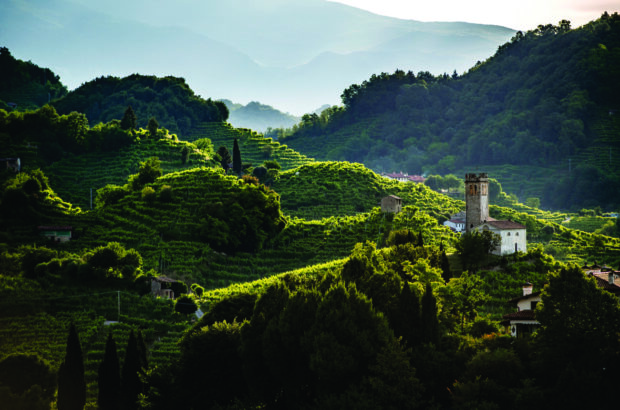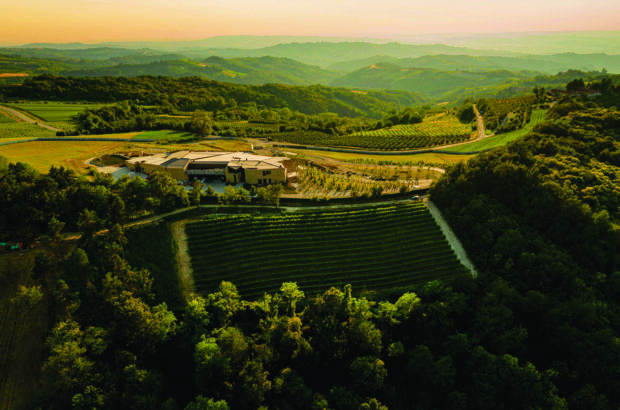For a region as traditional and steeped in history as Bordeaux, it’s refreshing to see new initiatives, and even whole new categories, emerge with the goal of bringing wider attention to its lesser-known wines. The Médoc has, of course, its famous and unlikely-ever-to- change 1855 classification ranking estates from first to fifth growth, as well as its newly relaunched (in 2020), three-tier Cru Bourgeois du Médoc classification for estates that weren’t listed in the former (249 in all in the 2020 list). And over on the Right Bank, St-Emilion has its hotly contested classification that is revised every 10 years, the latest of which is currently being updated and will be revealed in September.
But a spotlight is now shining on the Graves appellation with the unveiling of its 10 new ambassadors, or ‘Ambassadeur de Graves’ estates.
Scroll down to see tasting notes and scores for the current Ambassadeur de Graves wines
Setting the scene
Situated on the Left Bank of the Garonne river, in the upstream part of the region, Graves lies to the southeast of Bordeaux city, with vineyards covering an area stretching over 50km. It’s reported to be one of the oldest of Bordeaux’s vine-growing areas, where estates were already trading wines as early as 1152 following the marriage of Henry Plantagenet (soon to become King Henry II of England) and France’s Eleanor of Aquitaine. The region later flourished between the 16th and 18th centuries when, for 300 years, before the development of the Médoc, all of the area north and south of Bordeaux was known as Les Graves and the wines sold as Vin de Graves.
Jumping forward to the 20th century, the Graves region saw classifications introduced in 1953 for red wines and completed in 1959 for white wines. No rankings were applied as such, but the 16 estates chosen – including Château Haut-Brion, which was already part of the 1855 classification – were then able to use the term ‘cru classé de Graves’. In 1987, those 16 estates were absorbed into the newly established Pessac-Léognan appellation situated on a thin strip to the north, stealing a little of Graves’ lustre despite the continuation of the Graves name.
{"content":"PGRpdiBjbGFzcz0iYnJlYWtvdXQgcGFsZXR0ZS1hIHBhbmVsIHBhbmVsLWRlZmF1bHQiPjxkaXYgY2xhc3M9InBhbmVsLWJvZHkiPjxkaXYgY2xhc3M9J2JyZWFrb3V0LWNvbnRlbnQnPjwvcD4KPGRpdiBjbGFzcz0iYWQtY29udGFpbmVyIGFkLWNvbnRhaW5lci0tbW9iaWxlIj4KPGRpdiBpZD0icG9zdC1pbmxpbmUtMiIgY2xhc3M9ImlwYy1hZHZlcnQiPjwvZGl2Pgo8L2Rpdj4KPGgyIHN0eWxlPSJ0ZXh0LWFsaWduOiBjZW50ZXI7Ij5BbWJhc3NhZGV1cnMgZGUgR3JhdmVzOiB0aGUgd2luZSBlc3RhdGVzIGFuZCB0aGVpciBjb21tdW5lczwvaDI+CjxoMz5HcmF2ZXMgQmxhbmMgMjAyMDwvaDM+CjxwPjxzdHJvbmc+Q2hhzIJ0ZWF1IExhIFJvc2UgU2Fycm9uIDwvc3Ryb25nPihTdC1QaWVycmUtZGUtTW9ucyk8YnIgLz4KPHN0cm9uZz5DaGHMgnRlYXUgTGFncmFuZ2U8L3N0cm9uZz4gKEFyYmFuYXRzKTxiciAvPgo8c3Ryb25nPkNsb3MgQm91cmdlbGF0PC9zdHJvbmc+IChDZcyBcm9ucyk8L3A+CjxoMz5HcmF2ZSBSb3VnZSAyMDE5PC9oMz4KPHA+PHN0cm9uZz5DaGHMgnRlYXUgZGUgQ2hhbnRlZ3JpdmU8L3N0cm9uZz4gKFBvZGVuc2FjKTxiciAvPgo8c3Ryb25nPkNoYcyCdGVhdSBDcmFiaXRleTwvc3Ryb25nPiAoUG9ydGV0cyk8YnIgLz4KPHN0cm9uZz5DaGHMgnRlYXUgZGUgUG9ydGV0czwvc3Ryb25nPiAoUG9ydGV0cyk8YnIgLz4KPHN0cm9uZz5DaGHMgnRlYXUgTWFydGlnbmFjPC9zdHJvbmc+IChQb3J0ZXRzKTxiciAvPgo8c3Ryb25nPkNoYcyCdGVhdSBNb3V0aW48L3N0cm9uZz4gKFBvcnRldHMpPGJyIC8+CjxzdHJvbmc+Q2hhzIJ0ZWF1IExhIFJvc2UgU2Fycm9uPC9zdHJvbmc+IChTdC1QaWVycmUtZGUtTW9ucyk8YnIgLz4KPHN0cm9uZz5DaGHMgnRlYXUgTGFncmFuZ2U8L3N0cm9uZz4gKEFyYmFuYXRzKTxiciAvPgo8c3Ryb25nPkNoYcyCdGVhdSBSb3F1ZXRhaWxsYWRlIExhIEdyYW5nZTwvc3Ryb25nPiAoTWF6ZcyAcmVzKTxiciAvPgo8c3Ryb25nPkNsb3MgQm91cmdlbGF0PC9zdHJvbmc+IChDZcyBcm9ucyk8YnIgLz4KPHN0cm9uZz5DbG9zIEZsb3JpZGXMgG5lPC9zdHJvbmc+IChQdWpvbHMtc3VyLUNpcm9uKTwvcD4KPHA+CjwvZGl2PjxkaXYgY2xhc3M9J2JyZWFrb3V0LWJ1dHRvbnMnPjxkaXYgY2xhc3M9J3Jvdyc+PC9kaXY+PC9kaXY+PC9kaXY+PC9kaXY+CjxkaXYgY2xhc3M9ImFkLWNvbnRhaW5lciBhZC1jb250YWluZXItLW1vYmlsZSI+PGRpdiBpZD0icG9zdC1pbmxpbmUtMyIgY2xhc3M9ImlwYy1hZHZlcnQiPjwvZGl2PjwvZGl2Pgo8aHI+CjxoMj5BIG5ldyBlcmE8L2gyPgo8ZGl2IGlkPSJhdHRhY2htZW50XzQ4MjQ1NiIgc3R5bGU9IndpZHRoOiAxMzEwcHgiIGNsYXNzPSJ3cC1jYXB0aW9uIGFsaWdubm9uZSI+PGltZyBmZXRjaHByaW9yaXR5PSJoaWdoIiBkZWNvZGluZz0iYXN5bmMiIGFyaWEtZGVzY3JpYmVkYnk9ImNhcHRpb24tYXR0YWNobWVudC00ODI0NTYiIGNsYXNzPSJsYXp5bG9hZCBibHVyLXVwIHdwLWltYWdlLTQ4MjQ1NiBzaXplLWZ1bGwiIGRhdGEtcHJvY2Vzc2VkIHNyYz0iaHR0cHM6Ly93d3cuZGVjYW50ZXIuY29tL3dwLWNvbnRlbnQvdGhlbWVzL3NpbWJhLXRoZW1lL2Fzc2V0cy9pbWFnZXMvcGxhY2Vob2xkZXIucG5nIiBkYXRhLXNyYz0iaHR0cHM6Ly9rZXlhc3NldHMudGltZWluY3VrLm5ldC9pbnNwaXJld3AvbGl2ZS93cC1jb250ZW50L3VwbG9hZHMvc2l0ZXMvMzQvMjAyMi8wNi9XZWJfREVTMjc1LmFtYmFzc2FkZXVycy5jaGFfdGVhdV9kZV9jaGFudGVncml2ZS5qcGciIGFsdD0iIiB3aWR0aD0iMTMwMCIgaGVpZ2h0PSI4NjYiIGRhdGEtc2l6ZXM9ImF1dG8iIGRhdGEtc3Jjc2V0PSJodHRwczovL2tleWFzc2V0cy50aW1laW5jdWsubmV0L2luc3BpcmV3cC9saXZlL3dwLWNvbnRlbnQvdXBsb2Fkcy9zaXRlcy8zNC8yMDIyLzA2L1dlYl9ERVMyNzUuYW1iYXNzYWRldXJzLmNoYV90ZWF1X2RlX2NoYW50ZWdyaXZlLmpwZyAxMzAwdywgaHR0cHM6Ly9rZXlhc3NldHMudGltZWluY3VrLm5ldC9pbnNwaXJld3AvbGl2ZS93cC1jb250ZW50L3VwbG9hZHMvc2l0ZXMvMzQvMjAyMi8wNi9XZWJfREVTMjc1LmFtYmFzc2FkZXVycy5jaGFfdGVhdV9kZV9jaGFudGVncml2ZS0zMDB4MjAwLmpwZyAzMDB3LCBodHRwczovL2tleWFzc2V0cy50aW1laW5jdWsubmV0L2luc3BpcmV3cC9saXZlL3dwLWNvbnRlbnQvdXBsb2Fkcy9zaXRlcy8zNC8yMDIyLzA2L1dlYl9ERVMyNzUuYW1iYXNzYWRldXJzLmNoYV90ZWF1X2RlX2NoYW50ZWdyaXZlLTYzMHg0MjAuanBnIDYzMHcsIGh0dHBzOi8va2V5YXNzZXRzLnRpbWVpbmN1ay5uZXQvaW5zcGlyZXdwL2xpdmUvd3AtY29udGVudC91cGxvYWRzL3NpdGVzLzM0LzIwMjIvMDYvV2ViX0RFUzI3NS5hbWJhc3NhZGV1cnMuY2hhX3RlYXVfZGVfY2hhbnRlZ3JpdmUtMTM1eDkwLmpwZyAxMzV3LCBodHRwczovL2tleWFzc2V0cy50aW1laW5jdWsubmV0L2luc3BpcmV3cC9saXZlL3dwLWNvbnRlbnQvdXBsb2Fkcy9zaXRlcy8zNC8yMDIyLzA2L1dlYl9ERVMyNzUuYW1iYXNzYWRldXJzLmNoYV90ZWF1X2RlX2NoYW50ZWdyaXZlLTMyMHgyMTMuanBnIDMyMHcsIGh0dHBzOi8va2V5YXNzZXRzLnRpbWVpbmN1ay5uZXQvaW5zcGlyZXdwL2xpdmUvd3AtY29udGVudC91cGxvYWRzL3NpdGVzLzM0LzIwMjIvMDYvV2ViX0RFUzI3NS5hbWJhc3NhZGV1cnMuY2hhX3RlYXVfZGVfY2hhbnRlZ3JpdmUtNjIweDQxMy5qcGcgNjIwdywgaHR0cHM6Ly9rZXlhc3NldHMudGltZWluY3VrLm5ldC9pbnNwaXJld3AvbGl2ZS93cC1jb250ZW50L3VwbG9hZHMvc2l0ZXMvMzQvMjAyMi8wNi9XZWJfREVTMjc1LmFtYmFzc2FkZXVycy5jaGFfdGVhdV9kZV9jaGFudGVncml2ZS05MjB4NjEzLmpwZyA5MjB3LCBodHRwczovL2tleWFzc2V0cy50aW1laW5jdWsubmV0L2luc3BpcmV3cC9saXZlL3dwLWNvbnRlbnQvdXBsb2Fkcy9zaXRlcy8zNC8yMDIyLzA2L1dlYl9ERVMyNzUuYW1iYXNzYWRldXJzLmNoYV90ZWF1X2RlX2NoYW50ZWdyaXZlLTEyMjB4ODEzLmpwZyAxMjIwdyIgc2l6ZXM9IihtYXgtd2lkdGg6IDEzMDBweCkgMTAwdncsIDEzMDBweCIgLz48cCBpZD0iY2FwdGlvbi1hdHRhY2htZW50LTQ4MjQ1NiIgY2xhc3M9IndwLWNhcHRpb24tdGV4dCI+Q2jDonRlYXUgZGUgQ2hhbnRlZ3JpdmU8L3A+PC9kaXY+CjxwPlRoZSBBbWJhc3NhZGV1ciBkZSBHcmF2ZXMgcHJvamVjdCB3YXMgb2ZmaWNpYWxseSB1bnZlaWxlZCBpbiBKdWx5IDIwMjEsIHdpdGggdGhlIGludGVudGlvbiBvZiBkaXN0aW5ndWlzaGluZyB0aGUgd2luZXMgYW5kIHByb3BlcnRpZXMgdGhhdCBjYW4gYmUgYSDigJhkcml2aW5nIGZvcmNlIGZvciB0aGUgYXBwZWxsYXRpb24gaW4gdGVybXMgb2YgaW1hZ2UgYW5kIGF0dHJhY3RpdmVuZXNz4oCZLCBzYXlzIE1heWV1bCBs4oCZSHVpbGxpZXIsIGRpcmVjdG9yIG9mIHRoZSBTeW5kaWNhdCBWaXRpY29sZSBkZXMgR3JhdmVzLiBUaGUgd2luZXMgdGhhdCBjYXJyeSB0aGUgcmVjb2duaXRpb24sIGFuZCBjcnVjaWFsbHkgdGhlIGxhYmVsLCBhcmUgZnJvbSB0aGUgbmV3ZXN0IGJvdHRsZWQgdmludGFnZXM6IHRoZSAyMDE5IHJlZHMgYW5kIHRoZSAyMDIwIHdoaXRlcy48L3A+CjxkaXYgY2xhc3M9ImFkLWNvbnRhaW5lciBhZC1jb250YWluZXItLW1vYmlsZSI+PGRpdiBpZD0icG9zdC1pbmxpbmUtNCIgY2xhc3M9ImlwYy1hZHZlcnQiPjwvZGl2PjwvZGl2Pgo8cD5UaGUgYWltLCBhY2NvcmRpbmcgdG8gbOKAmUh1aWxsaWVyLCB3YXM6IOKAmFRvIG9mZmVyIHdpbmUgbG92ZXJzIGEgc2ltcGxpZmllZCB3YXkgb2YgaWRlbnRpZnlpbmcgd2luZXMgYW5kIHByb3BlcnRpZXMgdGhhdCBkZW1vbnN0cmF0ZSB0aGUga25vdy1ob3cgb2YgdGhlIEdyYXZlcyBhcHBlbGxhdGlvbiBpbiB0ZXJtcyBvZiB0aHJlZSBrZXkgY3JpdGVyaWEu4oCZIFRoZXNlIGFyZTogcmVzcGVjdCBmb3IgdGhlIHZpbmUsIG5hdHVyZSBhbmQgdGhlIGVudmlyb25tZW50OyB0aGUgYWJpbGl0eSB0byB3ZWxjb21lIHRoZSBwdWJsaWMgdG8gdGhlIHByb3BlcnR5IGluIHRoZSBiZXN0IGNvbmRpdGlvbnM7IGFuZCBtYXN0ZXJ5IG9mIHRoZSB3aW5lbWFraW5nIHByb2Nlc3MuPC9wPgo8cD5ObyB3ZWlnaHRpbmcgaXMgYXBwbGllZDsgb25seSBlc3RhdGVzIHRoYXQgc3VjY2Vzc2Z1bGx5IHNhdGlzZnkgZWFjaCBlbGVtZW50IGFyZSBjb25zaWRlcmVkLiBUaGUgZmlyc3QgY3JpdGVyaW9uIG11c3QgYmUgbWV0IGJ5IGVpdGhlciBiZWluZyBjZXJ0aWZpZWQsIG9yIGluIG9yZ2FuaWMgY29udmVyc2lvbiwgb3IgYWRoZXJpbmcgdG8gSFZFMyAoSGF1dGUgVmFsZXVyIEVudmlyb25uZW1lbnRhbGUpIGFuZCBJU08xNDAwMSBzdGFuZGFyZHMuIFRoZSBzZWNvbmQgaXMgbWV0IGJ5IGhhdmluZyBhbHJlYWR5IGFjaGlldmVkIGFjY3JlZGl0YXRpb24gZnJvbSBWaWdub2JsZXMgJmFtcDsgRGXMgWNvdXZlcnRlcyAoRnJhbmNl4oCZcyBuYXRpb25hbCB3aW5lIHRvdXJpc20gc2NoZW1lKSBmb3Igd2VsY29taW5nIGd1ZXN0cy4gQ3JlYXRlZCBpbiAyMDA5LCB0aGlzIGlzIGF3YXJkZWQgZm9yIGEgcGVyaW9kIG9mIHRocmVlIHllYXJzIHRvIGVzdGF0ZXMgdGhhdCBvZmZlciDigJhtdWx0aXBsZSBhbmQgY29tcGxlbWVudGFyeSB0b3VyaXN0IGF0dHJhY3Rpb25zLCBzb21lIG9mIHdoaWNoIGluY2x1ZGUgYWNjb21tb2RhdGlvbiwgY2F0ZXJpbmcgc2VydmljZXMsIGNlbGxhciB2aXNpdHMgYW5kIHRhc3Rpbmdz4oCZLiBMYXN0bHksIG9ubHkgd2luZXMgbWFkZSBpbiBjb21wbGlhbmNlIHdpdGggdGhlIEdyYXZlcyBhcHBlbGxhdGlvbiBydWxlcyBjYW4gYXBwbHkgKHNlZSA8YSBocmVmPSJodHRwOi8vdmluc2RlZ3JhdmVzLmNvbSI+PHN0cm9uZz52aW5zZGVncmF2ZXMuY29tPC9zdHJvbmc+PC9hPikuPC9wPgo8ZGl2IGNsYXNzPSJhZC1jb250YWluZXIgYWQtY29udGFpbmVyLS1tb2JpbGUiPjxkaXYgaWQ9InBvc3QtaW5saW5lLTUiIGNsYXNzPSJpcGMtYWR2ZXJ0Ij48L2Rpdj48L2Rpdj4KPGgyPkNvbnN1bWVyIGluZmx1ZW5jZTwvaDI+CjxwPkVsaWdpYmxlIHdpbmVzIGFyZSB0aGVuIHRhc3RlZCBhbmQgcmF0ZWQsIGFuZCBoZXJl4oCZcyB3aGVyZSBpdCBnZXRzIGludGVyZXN0aW5nLiBXaGlsZSBvdGhlciBzdWNoIGxhYmVscyBtYXkgYWxzbyB0YWtlIGludG8gYWNjb3VudCByZXNwZWN0IGZvciB0aGUgZW52aXJvbm1lbnQgb3Igd2luZSB0b3VyaXNtIGFjdGl2aXRpZXMsIHRoZSBkaXN0aW5ndWlzaGluZyBlbGVtZW50IG9mIHRoZSBBbWJhc3NhZGV1ciBkZSBHcmF2ZXMgd2luZXMgaXMgdGhhdCB0aGV5IHdlcmUgdWx0aW1hdGVseSBjaG9zZW4gb24gdGhlIGJhc2lzIG9mIGNvbnN1bWVyIHByZWZlcmVuY2UuPC9wPgo8cD5BIHBhbmVsIG9mIDEwMCDigJhpbmZvcm1lZCB3aW5lIGNvbnN1bWVyc+KAmSB3ZXJlIGNob3NlbiBieSBUZWNobmnigJlTZW5zLCBhIHNwZWNpYWxpc3QgaW5zdGl0dXRlIGZvciBhbmFseXNpcyBhbmQgc2Vuc29yeSBzdHVkaWVzLCB3aGljaCBjb25kdWN0ZWQgdGhlIHRhc3RpbmcuIE9yZ2FuaXNlZCBha2luIHRvIGEgcHJvZmVzc2lvbmFsIHRhc3RpbmcsIGFzc2Vzc21lbnRzIHdlcmUgbWFkZSBvZiBhIHdpbmXigJlzIHZpc3VhbCBhc3BlY3RzLCBhcm9tYXMgYW5kIGZsYXZvdXJzLCB3aXRoIGFuIG92ZXJhbGwgb3BpbmlvbiBnaXZlbiBhdCB0aGUgZW5kLiDigJhJbiB0aGUgYWdlIG9mIGhvcml6b250YWwgcmVjb21tZW5kYXRpb25zIGJ5IHBlZXJzLCBhIHdpbmUgbG92ZXIgbXVzdCBiZSBhYmxlIHRvIGVhc2lseSBpZGVudGlmeSB0aGUgd2luZXMgdGhhdCB3aWxsIHBsZWFzZSB0aGVtLOKAmSBzYXlzIGzigJlIdWlsbGllci4g4oCYVGhhdCBpcyB3aHkgd2Ugd2FudGVkIHdpbmUgbG92ZXJzIHRoZW1zZWx2ZXMgdG8gYmUgdGhlIG9uZXMgdG8gdGFzdGUgYW5kIHNlbGVjdCB0aGUgW0FtYmFzc2FkZXVyIGRlIEdyYXZlc10gd2luZXMg4oCTIHdoaWNoIGlzIHVuaXF1ZSBpbiBGcmFuY2UsIHRvIG91ciBrbm93bGVkZ2UuPC9wPgo8cD7igJhUb2RheSwgcmV0YWlsZXJzIGFuZCBtZXJjaGFudHMgYXJlIGxvb2tpbmcgZm9yIHRvb2xzIHRvIHJldml0YWxpc2UgdGhlIHdpbmUgbWFya2V0LiBDdXN0b21lciByZWNvbW1lbmRhdGlvbiBpcyB2ZXJ5IHByZXNlbnQgZm9yIG1hbnkgcHJvZHVjdHMsIGJ1dCByZW1haW5zIGV4dHJlbWVseSBtYXJnaW5hbCBmb3Igd2luZSzigJkgbOKAmUh1aWxsaWVyIGFkZHMuPC9wPgo8cD5UaGUgc2VudGltZW50IGlzIGVjaG9lZCBieSBGYWJyaWNlIFJleW5hdWQsIGNvLW93bmVyIG9mIGZhbWlseSBlc3RhdGUgYW5kIEFtYmFzc2FkZXVyIENoYcyCdGVhdSBMYWdyYW5nZTog4oCYV2hhdCBpcyBpbXBvcnRhbnQgaXMgdGhlIENsb3MgRmxvcmlkZcyAbmUgdW5pcXVlIHNlbGVjdGlvbiBtZXRob2QsIHdoaWNoIHNob3VsZCBnaXZlIGJ1eWVycyBjb25maWRlbmNlLOKAmSBoZSBzYXlzLiDigJhPdmVyYWxsLCBjb25zdW1lcnMgd2FudCBhbiBpcnJlcHJvYWNoYWJsZSB3aW5lIGluIHRlcm1zIG9mIHRhc3RlIHdpdGggYW4gaW5jcmVhc2luZ2x5IGVjby1yZXNwb25zaWJsZSBwcm9kdWN0aW9uIG1ldGhvZC4gVGhlIGlkZWEgaXMgdG8gcmVhc3N1cmUgY29uc3VtZXJzIGJ5IGd1YXJhbnRlZWluZyB0aGUgcXVhbGl0eSBvZiB0aGUgQW1iYXNzYWRvcnMsIGNob3NlbiBieSBhIHBhbmVsIHRoYXQgcmVwcmVzZW50cyB0aGVtLuKAmTwvcD4KPHA+UGFzY2FsIEd1aWduYXJkLCB3aG8gcnVucyBBbWJhc3NhZGV1ciBlc3RhdGUgQ2hhzIJ0ZWF1IFJvcXVldGFpbGxhZGUgTGEgR3JhbmdlLCBhZ3JlZXMgdGhhdCDigJhxdWFsaXR5IGlzIGtleeKAmSwgd2l0aCB0aGUgcHJvY2VzcyBpbnZvbHZlZCDigJhwcm92aWRpbmcgdGhhdCBjZXJ0YWludHnigJkuIEhlIGFkZHM6IOKAmFRoaXMgbGFiZWwgaXMgaW1wb3J0YW50IHRvIGJyaW5nIEFQIEdyYXZlcyB0byB0aGUgZm9yZSwgYW5kIHRvIHNob3cgdGhhdCB0aGVzZSB3aW5lcyBjYW4gY29tcGV0ZSB3aXRoIHRoZSBiZXN0IGZyb20gb3RoZXIgYXBwZWxsYXRpb25zLuKAmTwvcD4KPGRpdiBjbGFzcz0iYnJlYWtvdXQgcGFsZXR0ZS1hIHBhbmVsIHBhbmVsLWRlZmF1bHQiPjxkaXYgY2xhc3M9InBhbmVsLWJvZHkiPjxkaXYgY2xhc3M9J2JyZWFrb3V0LWNvbnRlbnQnPjwvcD4KPGgyPkdyYXZlcyBzdHlsZSAmYW1wOyB0ZXJyb2lyPC9oMj4KPHA+VGhlIEdyYXZlcyByZWdpb24gb3dlcyBpdHMgbmFtZSB0byB0aGUgZ3JhdmVscyBvZiB2YXJ5aW5nIHNpemVzIHRoYXQgb3ZlcmxheSBpdHMgcG9vciwgd2VsbC0gZHJhaW5lZCBzdWJzb2lscyBjb21wb3NlZCBvZiBzYW5kLCBjbGF5LCBsaW1lc3RvbmUsIHNoZWxsIG1hcmwgYW5kIGlyb24uIFRoZSBzdG9uZXMgcmVmbGVjdCB0aGUgc3VuIGFuZCByZWRpc3RyaWJ1dGUgaXRzIGhlYXQgdG8gdGhlIHZpbmVzLCBlbnN1cmluZyBvcHRpbWFsIG1hdHVyYXRpb24gb2YgdGhlIGdyYXBlcy4gVGhlIGNsaW1hdGUgaXMgbWlsZCBhbmQgdGVtcGVyYXRlLCB0aGFua3MgdG8gb2NlYW5pYyBpbmZsdWVuY2VzLCB3aXRoIHRoZSBtb2RlcmF0aW5nIHJpdmVyIEdhcm9ubmUgYm9yZGVyaW5nIHRoZSBlYXN0IHByb3ZpZGluZyBmcm9zdCBtaXRpZ2F0aW9uIGFuZCB0aGUgcGluZSBmb3Jlc3Qgb2YgdGhlIExhbmRlcyB0byB0aGUgd2VzdCBnaXZpbmcgcHJvdGVjdGlvbiBmcm9tIHdpbmRzLjwvcD4KPHA+VGhlIGFyZWEgcHJvZHVjZXMgcmVkIEdyYXZlcywgZHJ5IHdoaXRlIEdyYXZlcyBhbmQgYSB0aW55IHByb2R1Y3Rpb24gb2Ygc3dlZXQgYW5kIHNlbWktc3dlZXQgKG1vZWxsZXV4KSB3aGl0ZXMga25vd24gYXMgR3JhdmVzIFN1cGXMgXJpZXVyZXMuPC9wPgo8cD5UaGVyZSBpcyBhIHJvdWdobHkgNzAvMzAgc3BsaXQgYmV0d2VlbiByZWQgYW5kIHdoaXRlIGdyYXBlIHBsYW50aW5ncy4gRm9yIHJlZHMsIDxhIGhyZWY9Imh0dHBzOi8vd3d3LmRlY2FudGVyLmNvbS93aW5lL2dyYXBlLXZhcmlldGllcy9tZXJsb3QvIj48c3Ryb25nPk1lcmxvdDwvc3Ryb25nPjwvYT4gYW5kIDxhIGhyZWY9Imh0dHBzOi8vd3d3LmRlY2FudGVyLmNvbS93aW5lL2dyYXBlLXZhcmlldGllcy9jYWJlcm5ldC1zYXV2aWdub24vIj48c3Ryb25nPkNhYmVybmV0IFNhdXZpZ25vbjwvc3Ryb25nPjwvYT4gZG9taW5hdGUgYWxvbmdzaWRlIHNtYWxsIHBlcmNlbnRhZ2VzIG9mIDxhIGhyZWY9Imh0dHBzOi8vd3d3LmRlY2FudGVyLmNvbS93aW5lL2dyYXBlLXZhcmlldGllcy9jYWJlcm5ldC1mcmFuYy8iPjxzdHJvbmc+Q2FiZXJuZXQgRnJhbmM8L3N0cm9uZz48L2E+LCA8YSBocmVmPSJodHRwczovL3d3dy5kZWNhbnRlci5jb20vd2luZS9ncmFwZS12YXJpZXRpZXMvcGV0aXQtdmVyZG90LyI+PHN0cm9uZz5QZXRpdCBWZXJkb3Q8L3N0cm9uZz48L2E+LCA8YSBocmVmPSJodHRwczovL3d3dy5kZWNhbnRlci5jb20vd2luZS9ncmFwZS12YXJpZXRpZXMvY2FybWVuZXJlLyI+PHN0cm9uZz5DYXJtZW5lzIByZTwvc3Ryb25nPjwvYT4gYW5kIDxhIGhyZWY9Imh0dHBzOi8vd3d3LmRlY2FudGVyLmNvbS93aW5lL2dyYXBlLXZhcmlldGllcy9tYWxiZWMvIj48c3Ryb25nPk1hbGJlYzwvc3Ryb25nPjwvYT4gKENvdCkuIFRoZXNlIHdpbmVzIGFyZSBnZW5lcmFsbHkgY2hhcm1pbmcgYW5kIGVhc3kgdG8gZHJpbmssIGJhbGFuY2luZyB0aGUgZmxlc2h5IHJvdW5kbmVzcyBvZiB0aGUgd2luZXMgdG8gdGhlIHNvdXRoIGFuZCB0aGUgZmlybSBncmlwIG9mIHRob3NlIHRvIHRoZSBub3J0aC48L3A+CjxwPlRoZSBkcnkgd2hpdGVzIGFyZSBnZW5lcmFsbHkgYmxlbmRzIG9mIDxhIGhyZWY9Imh0dHBzOi8vd3d3LmRlY2FudGVyLmNvbS93aW5lL2dyYXBlLXZhcmlldGllcy9zZW1pbGxvbi1ncmFwZS12YXJpZXRpZXMvIj48c3Ryb25nPlNlbWlsbG9uPC9zdHJvbmc+PC9hPiBhbmQgPGEgaHJlZj0iaHR0cHM6Ly93d3cuZGVjYW50ZXIuY29tL3dpbmUvZ3JhcGUtdmFyaWV0aWVzL3NhdXZpZ25vbi1ibGFuYy8iPjxzdHJvbmc+U2F1dmlnbm9uIEJsYW5jPC9zdHJvbmc+PC9hPiB3aXRoIHNtYWxsIHBlcmNlbnRhZ2VzIGFsbG93ZWQgb2YgU2F1dmlnbm9uIEdyaXMgYW5kIE11c2NhZGVsbGUsIHdoaWNoIGNhbiBhbHNvIGJlIHVzZWQgaW4gdGhlIEdyYXZlcyBTdXBlzIFyaWV1cmVzLiBUaGVzZSB3aW5lcyBhcmUgdHlwaWNhbGx5IGNyaXNwLCBlbGVnYW50bHkgZmxvcmFsIGFuZCBkZWxpY2lvdXMgeW91bmcsIHRob3VnaCBjb250aW51ZSB0byBldm9sdmUgb3ZlciBmaXZlIG9yIHNpeCB5ZWFycy48L3A+CjxwPgo8L2Rpdj48ZGl2IGNsYXNzPSdicmVha291dC1idXR0b25zJz48ZGl2IGNsYXNzPSdyb3cnPjwvZGl2PjwvZGl2PjwvZGl2PjwvZGl2Pgo8aHI+CjxoMj5Vbml0eSAmYW1wOyBmb3J3YXJkLXRoaW5raW5nPC9oMj4KPGRpdiBpZD0iYXR0YWNobWVudF80ODI0NTciIHN0eWxlPSJ3aWR0aDogMTMxMHB4IiBjbGFzcz0id3AtY2FwdGlvbiBhbGlnbm5vbmUiPjxpbWcgZGVjb2Rpbmc9ImFzeW5jIiBhcmlhLWRlc2NyaWJlZGJ5PSJjYXB0aW9uLWF0dGFjaG1lbnQtNDgyNDU3IiBjbGFzcz0ibGF6eWxvYWQgYmx1ci11cCB3cC1pbWFnZS00ODI0NTcgc2l6ZS1mdWxsIiBkYXRhLXByb2Nlc3NlZCBzcmM9Imh0dHBzOi8vd3d3LmRlY2FudGVyLmNvbS93cC1jb250ZW50L3RoZW1lcy9zaW1iYS10aGVtZS9hc3NldHMvaW1hZ2VzL3BsYWNlaG9sZGVyLnBuZyIgZGF0YS1zcmM9Imh0dHBzOi8va2V5YXNzZXRzLnRpbWVpbmN1ay5uZXQvaW5zcGlyZXdwL2xpdmUvd3AtY29udGVudC91cGxvYWRzL3NpdGVzLzM0LzIwMjIvMDYvV2ViX0RFUzI3NS5hbWJhc3NhZGV1cnMuNDgxNF9waF9jcmFiaXRleV9hcm5hdWRfYnV0bGVyX2NyZWRpdF9lcmljX2JhcnJpZV9yZS5qcGciIGFsdD0iIiB3aWR0aD0iMTMwMCIgaGVpZ2h0PSI5OTciIGRhdGEtc2l6ZXM9ImF1dG8iIGRhdGEtc3Jjc2V0PSJodHRwczovL2tleWFzc2V0cy50aW1laW5jdWsubmV0L2luc3BpcmV3cC9saXZlL3dwLWNvbnRlbnQvdXBsb2Fkcy9zaXRlcy8zNC8yMDIyLzA2L1dlYl9ERVMyNzUuYW1iYXNzYWRldXJzLjQ4MTRfcGhfY3JhYml0ZXlfYXJuYXVkX2J1dGxlcl9jcmVkaXRfZXJpY19iYXJyaWVfcmUuanBnIDEzMDB3LCBodHRwczovL2tleWFzc2V0cy50aW1laW5jdWsubmV0L2luc3BpcmV3cC9saXZlL3dwLWNvbnRlbnQvdXBsb2Fkcy9zaXRlcy8zNC8yMDIyLzA2L1dlYl9ERVMyNzUuYW1iYXNzYWRldXJzLjQ4MTRfcGhfY3JhYml0ZXlfYXJuYXVkX2J1dGxlcl9jcmVkaXRfZXJpY19iYXJyaWVfcmUtMzAweDIzMC5qcGcgMzAwdywgaHR0cHM6Ly9rZXlhc3NldHMudGltZWluY3VrLm5ldC9pbnNwaXJld3AvbGl2ZS93cC1jb250ZW50L3VwbG9hZHMvc2l0ZXMvMzQvMjAyMi8wNi9XZWJfREVTMjc1LmFtYmFzc2FkZXVycy40ODE0X3BoX2NyYWJpdGV5X2FybmF1ZF9idXRsZXJfY3JlZGl0X2VyaWNfYmFycmllX3JlLTYzMHg0ODMuanBnIDYzMHcsIGh0dHBzOi8va2V5YXNzZXRzLnRpbWVpbmN1ay5uZXQvaW5zcGlyZXdwL2xpdmUvd3AtY29udGVudC91cGxvYWRzL3NpdGVzLzM0LzIwMjIvMDYvV2ViX0RFUzI3NS5hbWJhc3NhZGV1cnMuNDgxNF9waF9jcmFiaXRleV9hcm5hdWRfYnV0bGVyX2NyZWRpdF9lcmljX2JhcnJpZV9yZS0xMzV4MTA0LmpwZyAxMzV3LCBodHRwczovL2tleWFzc2V0cy50aW1laW5jdWsubmV0L2luc3BpcmV3cC9saXZlL3dwLWNvbnRlbnQvdXBsb2Fkcy9zaXRlcy8zNC8yMDIyLzA2L1dlYl9ERVMyNzUuYW1iYXNzYWRldXJzLjQ4MTRfcGhfY3JhYml0ZXlfYXJuYXVkX2J1dGxlcl9jcmVkaXRfZXJpY19iYXJyaWVfcmUtMzIweDI0NS5qcGcgMzIwdywgaHR0cHM6Ly9rZXlhc3NldHMudGltZWluY3VrLm5ldC9pbnNwaXJld3AvbGl2ZS93cC1jb250ZW50L3VwbG9hZHMvc2l0ZXMvMzQvMjAyMi8wNi9XZWJfREVTMjc1LmFtYmFzc2FkZXVycy40ODE0X3BoX2NyYWJpdGV5X2FybmF1ZF9idXRsZXJfY3JlZGl0X2VyaWNfYmFycmllX3JlLTYyMHg0NzUuanBnIDYyMHcsIGh0dHBzOi8va2V5YXNzZXRzLnRpbWVpbmN1ay5uZXQvaW5zcGlyZXdwL2xpdmUvd3AtY29udGVudC91cGxvYWRzL3NpdGVzLzM0LzIwMjIvMDYvV2ViX0RFUzI3NS5hbWJhc3NhZGV1cnMuNDgxNF9waF9jcmFiaXRleV9hcm5hdWRfYnV0bGVyX2NyZWRpdF9lcmljX2JhcnJpZV9yZS05MjB4NzA2LmpwZyA5MjB3LCBodHRwczovL2tleWFzc2V0cy50aW1laW5jdWsubmV0L2luc3BpcmV3cC9saXZlL3dwLWNvbnRlbnQvdXBsb2Fkcy9zaXRlcy8zNC8yMDIyLzA2L1dlYl9ERVMyNzUuYW1iYXNzYWRldXJzLjQ4MTRfcGhfY3JhYml0ZXlfYXJuYXVkX2J1dGxlcl9jcmVkaXRfZXJpY19iYXJyaWVfcmUtMTIyMHg5MzYuanBnIDEyMjB3IiBzaXplcz0iKG1heC13aWR0aDogMTMwMHB4KSAxMDB2dywgMTMwMHB4IiAvPjxwIGlkPSJjYXB0aW9uLWF0dGFjaG1lbnQtNDgyNDU3IiBjbGFzcz0id3AtY2FwdGlvbi10ZXh0Ij5Bcm5hdWQgZGUgQnV0bGVyLCBDaMOidGVhdSBDcmFiaXRleS4gQ3JlZGl0OiBFcmljIEJhcnJpw6hyZTwvcD48L2Rpdj4KPHA+VGhlIEFtYmFzc2FkZXVyIGRlIEdyYXZlcyBhc3Nlc3NtZW50IHdpbGwgYmUgcmVwZWF0ZWQgYW5udWFsbHkgZWFjaCBKdW5lLCB3aXRoIHRoaXMgeWVhcuKAmXMgc2VsZWN0aW9uIGNvdmVyaW5nIHRoZSAyMDIwIHZpbnRhZ2UgZm9yIHJlZCBHcmF2ZXMgYW5kIDIwMjEgZm9yIHdoaXRlLiBBcyBBcm5hdWQgZGUgQnV0bGVyLCBkaXJlY3RvciBhbmQgb3duZXIgb2YgQW1iYXNzYWRldXIgQ2hhzIJ0ZWF1IENyYWJpdGV5LCBwdXRzIGl0OiDigJhUaGUgbGFiZWwgaXMgd29uIGp1c3QgZm9yIG9uZSB2aW50YWdlLiBFYWNoIHllYXIgaXQgaXMgY2hhbGxlbmdlZCBpZiB5b3Ugd2FudCB0byBwYXJ0aWNpcGF0ZSBhZ2Fpbi7igJkgVGhpcyBhbHNvIGFsbG93cyBlc3RhdGVzIHRvIGNvbWUgYW5kIGpvaW4g4oCYd2hlbiB0aGV5IGZlZWwgcmVhZHnigJksIHNheXMgUmV5bmF1ZCwgYWRkaW5nOiDigJhUaGUgbWFpbiBpZGVhIGlzIGFsc28gdG8gdW5pdGUgYWxsIHRoZSB3aW5lLWdyb3dlcnMgdG8gaW5jcmVhc2Uga25vd2xlZGdlIG9mIEdyYXZlcyB3aW5lcy7igJk8L3A+CjxwPldoaWxlIHRoZSBBbWJhc3NhZGV1ciBkZSBHcmF2ZXMgbGFiZWwgaXMgc3RpbGwgaW4gaXRzIGluZmFuY3ksIHdpdGggdGltZSBuZWVkZWQgdG8gZXN0YWJsaXNoIGl0cyBzaWduaWZpY2FuY2UgbW9yZSBmaXJtbHkgb24gdGhlIG1hcmtldCwgZXN0YXRlcyBzdWNoIGFzIENyYWJpdGV5IGFuZCBMYWdyYW5nZSBoYXZlIGJlZW4gYnVveWVkIGJ5IHRoZSBpbml0aWF0aXZlIGFuZCB0aGUgZHJpdmUgdG8gZW5jb3VyYWdlIHBlb3BsZSB0byBkaXNjb3ZlciBvciByZWRpc2NvdmVyIEdyYXZlcy48L3A+CjxwPuKAmEV2ZXJ5b25lIGhhcyBiZWVuIHRob3JvdWdobHkgcmVtb3RpdmF0ZWQgYXQgdGhlIGVzdGF0ZSzigJkgc2F5cyBkZSBCdXRsZXIsIHdpdGggdGhlIGxhYmVsIOKAmG9mZmVyaW5nIGdyZWF0IHJlY29nbml0aW9uIG9mIGEgam9iIHdlbGwgZG9uZeKAmSwgd2hpbGUgUmV5bmF1ZCBjb21tZW50cyB0aGF0IOKAmGl0IHJld2FyZHMgdGhlIHdvcmsgb2YgYSB3aG9sZSB0ZWFtIGFuZCAxNSB5ZWFycyBvZiBlZmZvcnTigJkuPC9wPgo8cD5JbXBvcnRhbnRseSwgdGhpcyBuZXcgcmVmZXJlbmNlIHNob3VsZCBub3Qgb25seSByYWlzZSBhd2FyZW5lc3Mgb2YgdGhlIHdob2xlIEdyYXZlcyByZWdpb24sIGJ1dCBhbHNvIGhlbHAgd2luZXJpZXMgZXhwYW5kIG9udG8gdGhlIGludGVybmF0aW9uYWwgc3RhZ2Ug4oCTIGEgcXVhcnRlciBvZiB0aGlzIHllYXLigJlzIHNlbGVjdGlvbiBhcmUgbm90IGN1cnJlbnRseSBleHBvcnRpbmcgdGhlaXIgd2luZXMgb3V0c2lkZSBGcmFuY2UuIEZvciBHYXJldGggQmlyY2hsZXksIGJ1eWluZyBkaXJlY3RvciBvZiBVSy1iYXNlZCBCdXJucyAmYW1wOyBHZXJtYW4gVmludG5lcnMsIHRoZSBuZXcgbGFiZWwgY2FycmllcyBhcHBlYWwgZm9yIGJvdGggbWVyY2hhbnRzIGFuZCBlbmQtY29uc3VtZXJzLiDigJhJdOKAmXMgZ3JlYXQgdG8gc2VlIGEgbW9kZXJuIGFuZCByZWxldmFudCBjbGFzc2lmaWNhdGlvbiBvZiBzb3J0cyBjb21pbmcgb3V0IG9mIEJvcmRlYXV4LOKAmSBoZSBzYXlzLiDigJhJbiBTdC1FbWlsaW9uLCBmb3IgaW5zdGFuY2UsIHBlb3BsZSBhcmUgb3B0aW5nIG91dCBvZiBzdWNoIGFzc29jaWF0aW9ucywgeWV0IHRoZSBBbWJhc3NhZGV1ciBkZSBHcmF2ZXMgbWFuYWdlcyB0byB0aWNrIHRoZSBib3hlcyBjb25zdW1lcnMgYXJlIGxvb2tpbmcgZm9yLCByZWNvZ25pc2luZyBib3RoIHF1YWxpdGF0aXZlIGFuZCBlbnZpcm9ubWVudGFsbHkgZnJpZW5kbHkgdml0aWN1bHR1cmUgYXMgd2VsbCBhcyB0b3VyaXNtIGVmZm9ydHMu4oCZPC9wPgo8cD5BcyBjb25zdW1lcnMgYXJlIGZhY2VkIHdpdGggYW4gaW5jcmVhc2luZ2x5IGRpdmVyc2UgYW5kIHNvbWV0aW1lcyBpbnRpbWlkYXRpbmcgbnVtYmVyIG9mIHdpbmVzIG9uIHNoZWx2ZXMsIGJvdHRsZXMgc2hvd2Nhc2luZyB0aGlzIG5ldyBsYWJlbCwgaW5kaWNhdGluZyB0aGUg4oCYZGVzaWduYXRlZCBieSBjb25zdW1lcnPigJkgYmFkZ2UsIGVmZmVjdGl2ZWx5IHJlcGxhY2Ugd29yZC1vZi1tb3V0aCByZWNvbW1lbmRhdGlvbnMgYW5kIHdpbGwgc3VyZWx5IGdvIHNvbWUgd2F5IHRvIGhlbHBpbmcgcHVyY2hhc2luZyBkZWNpc2lvbnMuPC9wPgo8ZGl2IGNsYXNzPSJpbmplY3Rpb24iPjwvZGl2Pgo8cD7igJhQZW9wbGUgdXNlIFRyaXBhZHZpc29yIHRvIGRpc2Nlcm4gdGhlIHRvcCBwbGFjZXMgdG8gc3RheSBhbmQgdGhpcyB3aWxsIHdvcmsgaW4gYSBzaW1pbGFyIHdheSzigJkgc2F5cyBCaXJjaGxleS4g4oCYUGx1c+KAmSwgaGUgYWRkcywg4oCYYXMgaXTigJlzIHJlbmV3ZWQgZXZlcnkgeWVhciwgQW1iYXNzYWRldXIgZGUgR3JhdmVzIHdpbGwgYmUgb25lIG9mIHRoZSBtb3N0IHVwLXRvLWRhdGUgbGFiZWxzIHdvcnRoIHNlZWtpbmcgb3V0LuKAmTwvcD4KPHA+PGVtPkdlb3JnaW5hIEhpbmRsZSBpcyBEZWNhbnRlcuKAmXMgcmVnaW9uYWwgZWRpdG9yIGZvciBCdXJndW5keSBhbmQgQm9yZGVhdXgsIGFuZCBlZGl0b3Igb2YgRGVjYW50ZXIgUHJlbWl1bSBvbmxpbmUuIFNoZSBsaXZlcyBpbiBCb3JkZWF1eDwvZW0+PC9wPgo8cD4K"}
People’s choice: the current Ambassadeur de Graves wines
{}
{"wineId":"40462","displayCase":"standard","paywall":true}
{"wineId":"56959","displayCase":"standard","paywall":true}
{"wineId":"56964","displayCase":"standard","paywall":true}
{"wineId":"56938","displayCase":"standard","paywall":true}
{"wineId":"56942","displayCase":"standard","paywall":true}
{"wineId":"56943","displayCase":"standard","paywall":true}
{"wineId":"39800","displayCase":"standard","paywall":true}
{"wineId":"56945","displayCase":"standard","paywall":true}
{"wineId":"56947","displayCase":"standard","paywall":true}
{"wineId":"56949","displayCase":"standard","paywall":true}
{"wineId":"56954","displayCase":"standard","paywall":true}
{"wineId":"56960","displayCase":"standard","paywall":true}
{"wineId":"56961","displayCase":"standard","paywall":true}
{}
Related articles












